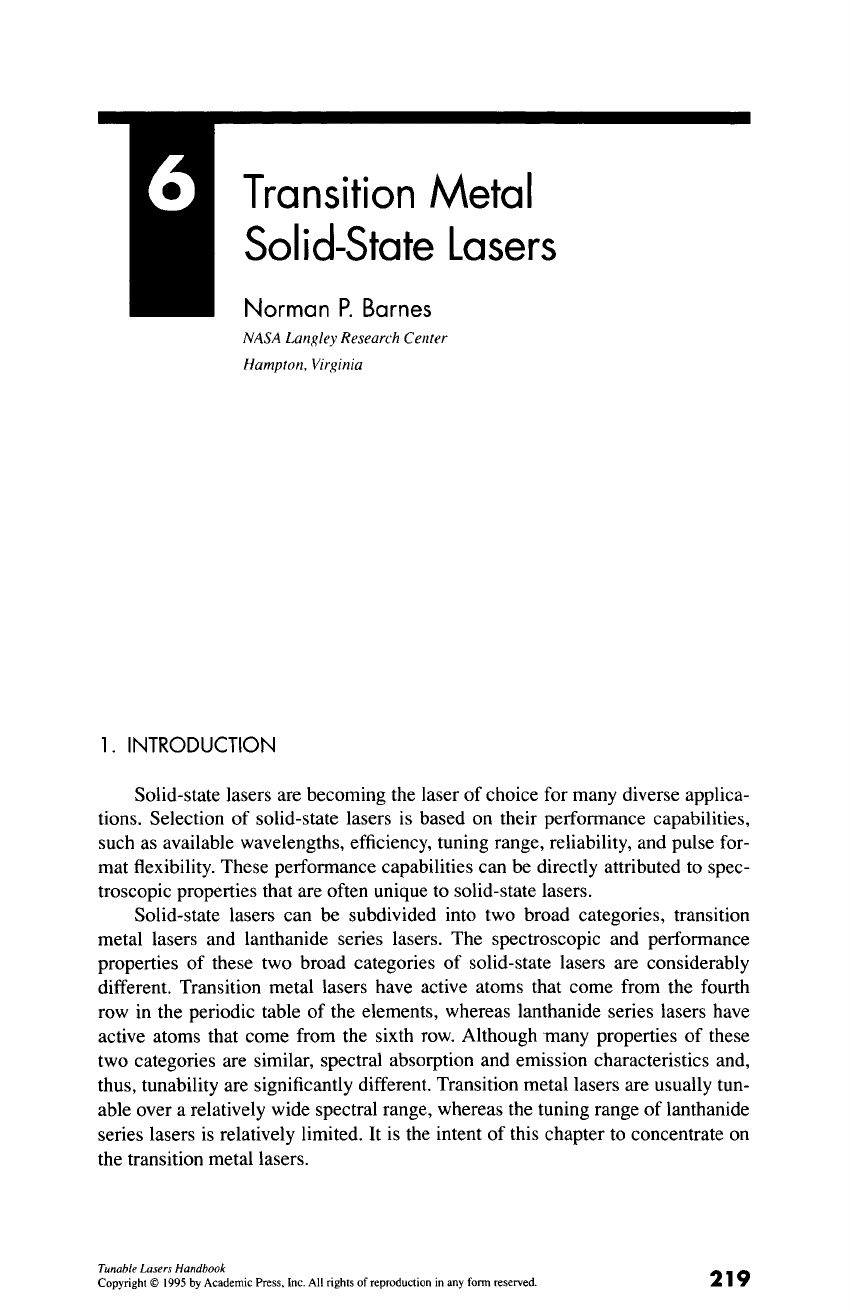
Transition Metal
Solid-State Lasers
Norman P. Barnes
NASA Langley Research Center
Hampton, Virginia
1. INTRODUCTION
Solid-state lasers are becoming the laser of choice for many diverse applica-
tions. Selection of solid-state lasers is based on their performance capabilities,
such as available wavelengths, efficiency, tuning range, reliability, and pulse for-
mat flexibility. These performance capabilities can be directly attributed to spec-
troscopic properties that are often unique to solid-state lasers.
Solid-state lasers can be subdivided into two broad categories, transition
metal lasers and lanthanide series lasers. The spectroscopic and performance
properties of these two broad categories of solid-state lasers are considerably
different. Transition metal lasers have active atoms that come from the fourth
row in the periodic table of the elements, whereas lanthanide series lasers have
active atoms that come from the sixth row. Although many properties of these
two categories are similar, spectral absorption and emission characteristics and,
thus, tunability are significantly different. Transition metal lasers are usually tun-
able over a relatively wide spectral range, whereas the tuning range of lanthanide
series lasers is relatively limited. It is the intent of this chapter to concentrate on
the transition metal lasers.
Tunable Lasers Handbook
Copyright
9
1995 by Academic Press, Inc. All rights of reproduction in any form reserved.
219

220 Norman P. Barnes
Tunability of transition metal solid-state lasers, a prime reason for their
selection, results from the interaction of the transition metal active atom with the
crystal field of the laser material. The electrons that participate in the lasing
process in transition metal lasers are the 3d electrons; the electrons that partici-
pate in the lasing process in lanthanide series lasers are the 4f electrons. Because
of the electronic configuration, the 3d electrons interact strongly with the crystal
field of the laser material, whereas the 4f electrons do not. It is the strong inter-
action of the electrons with the crystal field that produces the tunability. Tuning
ranges can be a very large fraction of the center wavelength. For example, the
ratio of the tuning range to the peak gain wavelength of Ti:A1203 is about 0.5,
providing one of the largest tuning ranges of any laser.
Solid-state lasers operate best in the near-infrared region of the spectrum,
from about 0.7 to 2.1 ktm. Operation at shorter wavelengths tends to be limited by
the lifetime of the upper laser level and laser material considerations. Material
considerations are associated with the pumping process because solid-state lasers
are optically pumped almost exclusively. Because the pump wavelength is almost
always shorter than the laser wavelength, the laser material must be transparent at
wavelengths considerably shorter than the laser wavelength. Because most optical
materials begin absorbing in the near ultraviolet, finding a laser material with the
requisite transparency becomes increasingly difficult as the laser wavelength moves
from the near infrared into the visible. On the other extreme, long-wavelength
operation of solid-state lasers is limited primarily by lifetime and quantum effi-
ciency considerations. As the laser wavelength becomes longer, an increasing
fraction of the excited laser atoms is lost to nonradiative decay processes. Non-
radiative decay processes deplete the upper laser level population density without
the emission of a photon, which, in turn, decreases the lifetime and quantum effi-
ciency. Nonradiative decay processes make it increasingly more difficult to create
a high upper laser level population density and thus reach threshold. High thresh-
olds limit the laser efficiency and if the thresholds are too high, eventually prevent
operation of solid state at the longer wavelengths lasers altogether.
Solid-state lasers offer a large variety of pulse formats, ranging from single
pulses with very large energies to continuous wave (cw) operation. At low pulse
repetition frequencies (prfs), solid-state lasers can be excited or pumped with a
pulsed source. Laser output pulse lengths can range from time intervals com-
mensurate with the pump pulse length to pulse lengths that are a tiny fraction of
the pump pulse length. When the laser operates with pulse lengths controlled by
the pump pulse length, the mode of operation is referred to as
normal mode.
To
obtain the short laser pulse lengths, and the high peak power associated with
them, an optical switch or Q-switch is employed. During most of the pump pulse
the Q-switch prevents lasing. However, because of the long lifetime of the upper
laser level, the pump energy can be stored in the upper laser level efficiently.
Near the end of the pump pulse, the Q-switch is opened and the majority of the
Get Tunable Lasers Handbook now with the O’Reilly learning platform.
O’Reilly members experience books, live events, courses curated by job role, and more from O’Reilly and nearly 200 top publishers.

